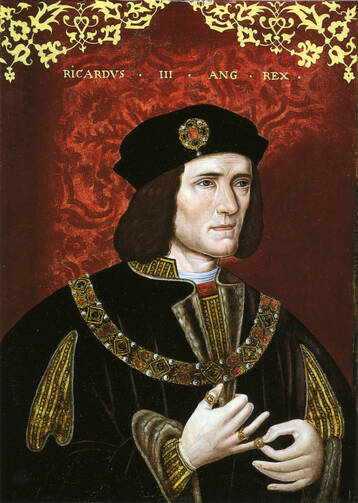How history is recited matters almost as much as what happened. When someone as talented as Shakespeare tells your tale, the image stays fixed.
Richard III’s physical description pales before the moral figure Shakespeare drew. His Richard is responsible for the murder of the weak Lancastrian King, Henry VI, and, when Richard’s brother becomes the Yorkish King Edward IV, Richard secures his own succession to the throne by engineering the execution of his other brother George, the Duke of Clarence. He also orders the heinous murder of his two young nephews, in the Tower of London.
Small wonder that when Richard was defeated by Henry Tudor at the Battle of Bosworth Field—for want of that famous horse—his corpse was desecrated and, some thought, his bones were thrown into the River Soar. But remember that Shakespeare’s great villain comes to us via Tudor historians—among them our own Saint Thomas More—who had good reason to support the coup accomplished by the man who became King Henry VII and whose descendents ruled England for a hundred years.
In August of 2012, skeletal remains were discovered beneath a Leichester parking lot, where once stood the choir of a Franciscan chapel. Shakespeare had the eloquence, but it was science that confirmed the physical identity of the man. DNA testing and carbon dating definitely established that the mortal remains of Richard III had been found. The King did indeed suffer from scoliosis, a marked curvature of his spine, though there is no evidence of a withered arm. The skeleton revealed multiple wounds, some not lethal, but two fierce blows to the skull, which certainly were. There was also a post-mortem injury to the pelvis, evidently inflicted by a still enraged opponent. Five and a quarter centuries later, the wounds of Richard III still witnessed to his death.
The wounds of Christ bespeak his story. They tell us that this is not a ghost, no figment of the imagination, nor simply the inspiration of Jesus, surviving his own demise. This is a man who has suffered a violent death, and it is this man who strides from the tomb as the victor of life.
The Risen Christ is all we know of heaven yet, more than enough. In seeing his wounds, we know that heaven fulfills and redeems our lives on earth. It is their consummation, not their cancelation. The glorified Christ still bears his wounds, the signs of his story, his history, inscribed in his flesh.
There is so much about our lives that defies comprehension, that challenges our very belief in a God of love and compassion. All this will be borne into death, taken before the face of God, where the mystery at work in our lives, in our stories and in our flesh will be revealed. The glorified Christ is the wounded Jesus. Sin and sorrow aren’t erased. They are transformed, redeemed.
This past month, the King was solemnly reburied in Leichester Cathedral. Thousands stood in line for three days to walk past the bier, holding his coffin of “golden English oak with an incised Yorkist rose and an inscription giving the sparest details of his life — ‘Richard III, 1452-1485.’”
The New York Times reported that
Five and a quarter centuries after his death, Richard emerges from the earth, still bearing his wounds, still being sifted in the judgment of men.
History isn’t cancelled by heaven. Eternity doesn’t annul the work of earth. The cosmos will have a consummation, the final revelation of a resurrected humanity, one rent yet redeemed. To borrow from the Bard, the winter of our discontent shall yet be made glorious summer.
Acts 4: 32-35 1 John 5: 1-6 John 20: 19-31








